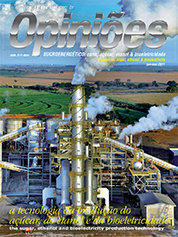Getúlio Tadeu Chaves de Andrade
President of GTCA Tecnologia e Consultoria
Op-AA-27
The industrial evolution
Between the end of the 19th century and the beginning of the 20th century, a major technological revolution took place in world industry. In the previous century, the steam engine (Watt, 1774) and the combustion engine (Philippe Lebon) were invented, having been the driving forces of this quick industrial development, considering that prior to it the world only knew windmills and water wheels as non-animal traction means.
Henry Ford, encouraged by the discovery of combustion engines, developed an organization and methods in his automobile plant, innovating with serial production. This was an amazing feature for the industrial revolution. At that time, the old sugar and ethanol mills ceased to extract juice in only one three roller mill with animal traction or even with human traction in mills with two to four roller mills.
This all was possible thanks to the introduction of 8 Kg/cm2 low pressure boilers that drove those then revolutionary steam machines. Engineering was a success and allowed the development of gear systems of a variety of sizes and combinations. With crushing becoming more significant, the need arose to replace open air evaporator pans with double, triple or even quadruple effect evaporators.
What a development at the time! Then, out of need, vacuum pans appeared, being the major step towards improving the heat balance. With the development of evaporation came the need to improve juice treatment, and thus, closed clarifiers, tubular heaters and press filters were developed. With the increase in crushing and production, the use of molasse cases (molasse holes, as they were called) and open air drying became unviable, because these kinds of separation and drying required a lot of space.
That was when batch centrifuges and subsequently continuous centrifuges came about. Then, drum dryers. We gradually evolved in terms of working pressure in boilers, and steam engines were replaced by steam turbines, which is the point in time when one starts to produce one’s own energy needed for the process.
This narrative seems to belong to a long gone time. But even nowadays there are still small plants that operate only three roller mills, tube-fired boilers, open air pans, using gravity purging and open air drying. They are few and limited, but enjoy a guaranteed market of naturalist consumers. We evolved from rotary cranes to hillos, 50º tables, high performance knives and shredders, and increasingly efficient crushing mills.
These are already being replaced by diffusers and low pressure roll extraction with low power consumption. In the treatment of juice, we went from huge lime mixers to compact systems with automatic control. Clarifiers already feature retention times of up to 30 minutes or less. Press filters were completely replaced by increasingly larger vacuum filters, and these by belt press filters.
Evaporation, increasingly more efficient, allows considerable reductions in steam consumption and therefore, the production of more exportable energy. Before, we had a consumption of 650 kg of steam per ton of cane, whereas nowadays we easily reach 380 kg per ton, but still have room for further reductions. The correct dimensioning of the evaporation set and the correct steam draining make this improvement possible, not to mention the new falling film evaporation techniques using plates and vacuum calandria pans.
Vacuum pans that previously were in batches of normally 150 hl, nowadays are automatic high-performance and high-capacity equipment that reaches up to 1,000 continuous hl. From single crystallizers without refrigeration we evolved to refrigerated Blanchard type crystallizers, then on to Werksporr equipment, and nowadays, vertical crystallizers.
This refrigeration was suited to better extract mother liquor from crystals. We still use Green Smith type mass heaters to achieve the right centrifugation temperature. Manual and batch centrifuges became automatic, with high purging efficiency, while continuous centrifuges achieved outstanding performance in terms of quality and quantity.
Sugar dryers became continuous flow rotative equipment, using steam for indirect heating, subsequently becoming refrigeration equipment. Then came the marvelous partially fluidized bed type dryers, and lastly, the fluidized bed type that are still a bet on the future. Boilers went from 8 to 16, 21, 25, 30, 42, 63 or 67, 84 and up to 100 Kg/cm2. Along came power generators of up to 45 MWh.
This also allowed heat balance requirements to evolve so that one could generate more power with the same volume of bagasse. We went from generating power – in the first steam turbines phase – at roughly 30 to 40 kWh/t of cane to up to 160 kWh/t of cane. Currently, many new technologies are being developed, expected to become economically feasible to then be implemented.
Studies and tests with molecular screens used in the treatment and concentration system are in progress, seeking to eliminate currently used sugar mill equipment such as: lime mixer, heaters, clarifiers, some of the evaporation equipment, and filters. In steam generation, bagasse gasification looks promising. Ethanol production will increase considerably using bagasse. We are close to seeing mills quite different than those in operation today. Man – the motive and reason of constant development –, will remain unchanged, because he dreams, thinks, conceives and realizes.




